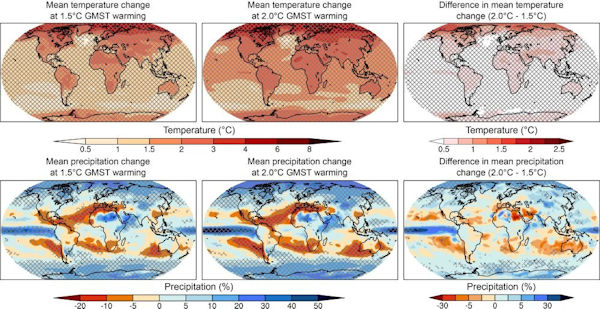SEJournal Online is the digital news magazine of the Society of Environmental Journalists. Learn more about SEJournal Online, including submission, subscription and advertising information.
 |
| An infographic showing projected changes in mean temperature and mean precipitation at 1.5°C and 2°C of global warming compared to the pre-industrial period. Image: IPCC. Click to enlarge. |
Feature: Covering New IPCC Reports Helps Explain Gravity of Climate Crisis
By Bob Berwyn
If the popular disaster movie meme about politicians ignoring scientists' warnings hasn't already started making the rounds again this week, perhaps it should following the release of the latest major international climate report. But beyond the dark humor, there's some serious reporting to be done.
The new report, released on Aug. 9 by the Intergovernmental Panel on Climate Change, or IPCC, assesses thousands of recent studies showing more clearly than ever how the buildup of carbon pollution is irrevocably melting ice caps and thawing permafrost, killing forests and crops, raising sea level and spurring deadly heat waves, droughts and wildfires.
The report from IPCC’s Working Group 1, “Climate Change 2021: The Physical Science Basis,” also uses new climate models to make more accurate and near-term projections of how the climate will respond to additional greenhouse gases, and how long it will take for the climate to stabilize — about 20 to 30 years — if emissions go to zero.
 |
| IPCC Vice-Chair Ko Barrett during an SEJ webinar previewing the IPCC report. Click to enlarge. |
The Working Group 1 report is from one of three working groups, each focusing on different aspects of the climate crisis as the IPCC develops its sixth assessment report (AR6), currently due for release in late 2022.
The Working Group 1 report was prepared by 234 authors from 66 countries and includes 14,000 scientific citations and more than 78,000 review comments. During the next 18 months, Working Group 2 will issue a report on climate change impacts, adaptation and vulnerability, while Working Group 3 finalizes its report on climate mitigation.
Ultimately, the IPCC’s full AR6 synthesis report will update the 2014 version that served as the scientific basis for the 2015 Paris Agreement, under which world leaders pledged to limit global warming to under 2 degrees Celsius, ideally closer to 1.5 degrees. The 2014 report is cited frequently by climate activists like the Fridays For Future movement, which is trying to hold governments accountable to the promises they made in Paris.
More robust approach to attribution science
The IPCC was formed in 1988 under the auspices of the United Nations as an international framework to grapple with a global problem that requires a global solution. Its reports, issued every two to five years, have charted the global scientific consensus on the dangers of global warming since the first edition in 1991, which highlighted the same climate threats, albeit with less certainty, than the updated edition released this week.
The reports aren’t prescriptive, but are intended to provide the best science information for decision-makers to help plan for, and adapt to, rising sea level, more variable and intense precipitation, dwindling water supplies and other climate impacts.
‘We have more years of data and we have
new methods to employ that I think will
demonstrate that there is a more robust
approach to attribution in this report.’
— IPCC Vice-Chair Ko Barrett
at a recent SEJ webinar
At a recent webinar hosted by the Society of Environmental Journalists, IPCC Vice-Chair Ko Barrett noted that the new report features an enhanced focus on attribution science, which models how much human-caused climate change is increasing the likelihood of weather extremes like heat waves. “We have more years of data and we have new methods to employ that I think will demonstrate that there is a more robust approach to attribution in this report,” Barrett said.
Advice for wrangling the climate change beat
Before trying to cover the IPCC reports, know that it’s tough to dive into for a short, one-time story. Climate change is an ongoing, in-depth beat, a challenge to keep up with even for a full-time climate reporter like myself. But if you can spend a little time prepping, using the extensive background material and earlier IPCC reports already available, you’ll have more of an idea how to proceed.
Writing effectively about IPCC reports
requires fully facing the depth of
what is more and more frequently
being called a global climate crisis.
Writing effectively about IPCC reports requires fully facing the depth of what is more and more frequently being called a global climate crisis; a potentially existential threat to at least parts of human society and nature. The science in the new report again shows that agriculture, transportation and water supply systems are likely to face severe disruptions in the coming decades, and that they will get worse if greenhouse gas levels keep increasing.
One of the best ways to cover the IPCC is to follow its activities, sign up for its briefings and stay connected with scientists working on the reports on an ongoing basis — an important part of any beat, not just the environment. Writing about the new report could include collaborations between reporters on different beats, everything from sports (extreme heat at the Tokyo Olympics), to business, culture and politics.
The best time to start thinking about covering the next IPCC reports is now, and the reporting that’s done on the Working Group 1 report can serve as a basis for writing about the next few releases. Staying up-to-date means getting the new science information in digestible bites rather than as an overwhelming tsunami of information when reports are released.
Localize your reporting, address environmental justice
Since the IPCC reports are written and compiled by hundreds of scientists from around the world, it’s usually possible to start localizing coverage by finding a scientist from your region to discuss how the conclusions are relevant for your audience. Other scientists at regional universities or research centers can also comment on the findings of IPCC reports as outside experts.
According to Barrett, the new report features a more regional approach to describing the effects of global warming than previous versions, rather than focusing on global averages. In the United States, the National Climate Assessment offers an even more detailed breakdown of regional climate impacts, and other countries around the world have national climate plans at various stages of completion.
The new report offers a chance to ask
whether local plans are keeping
pace with the latest science.
Even some local governments use IPCC science benchmarks to support decarbonization policies in sectors like transportation and building, so the new report offers a chance to revisit local planning and governance efforts, and to ask whether local plans are keeping pace with the latest science. Holding governments accountable to the pledges of the Paris Agreement is literally a matter of life and death for thousands of people.
Society has also changed since the Paris Agreement was reached in 2015. There is a heightened awareness that the world’s poorest people are suffering the most from global warming impacts, even though they did very little to cause the problem.
That holds true on a global scale, with less developed countries in the Global South taking the biggest hit, and on local and regional levels, where the poorest neighborhoods in cities, or immigrant farm workers in agricultural areas, are most susceptible to climate threats like extreme heat. The IPCC reports can be a powerful tool to bring climate science to the front and center to address environmental justice.
Steer clear of jargon
Practical tips for covering the reports include using all the IPCC resources, including signing up for regular updates and advance access to embargoed materials. That information can be enhanced with, or compared to, local and regional climate plans and projections, for example to check if local planning for sea level rise is in line with the latest global projections.
The IPCC also provides graphics to visualize the data in the reports — these can be a huge help to illustrate complex concepts. Similarly, NOAA and NASA have extensive archives of climate visualizations, including animations of sea level rise, ocean currents or hurricane paths, that can be used to enhance IPCC information.
Finally, don’t get caught up in scientific jargon. It’s important to know what things like “representative concentration pathways” or “shared socioeconomic pathways” are, and the labels help keep the complex information organized. But the important thing is to be able to translate the terms into something that will help readers understand what the information means for them.
Editor’s Note: For a curated list of stories about the IPCC Working Group report, check in with SEJ’s EJToday here. Also visit SEJ.org’s Climate Change Resource Guide (work in progress) and the Climate Change Issues page.
Bob Berwyn is an Austrian-based freelance reporter who has covered climate science and international climate policy for more than a decade. Previously, he reported on the environment, endangered species and public lands for several Colorado newspapers, and also worked as editor and assistant editor at community newspapers in the Colorado Rockies.
* From the weekly news magazine SEJournal Online, Vol. 6, No. 29. Content from each new issue of SEJournal Online is available to the public via the SEJournal Online main page. Subscribe to the e-newsletter here. And see past issues of the SEJournal archived here.













 Advertisement
Advertisement 



